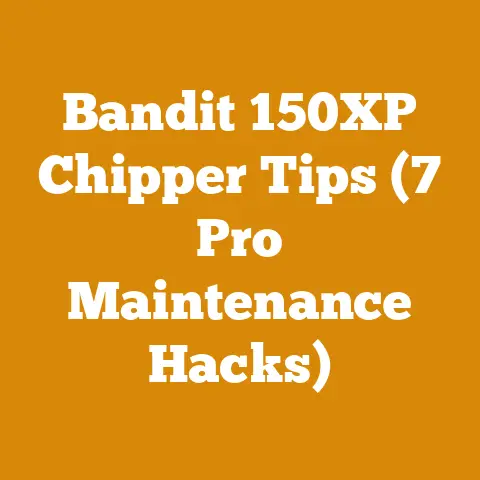Fuel Line Configuration Poulan Chainsaw (Expert Routing Tips)
“The best time to plant a tree was 20 years ago. The second best time is now.” – Chinese Proverb.
As someone who’s spent a good chunk of my life wrist-deep in sawdust and fueled by the scent of freshly cut wood, I can tell you firsthand that few things are as satisfying as felling a tree and turning it into a stack of usable firewood. But, like any craft worth mastering, wood processing has its intricacies. And one of the most crucial, often overlooked, aspects of keeping your chainsaw humming is understanding its fuel line configuration.
Understanding the Heart of Your Poulan Chainsaw: The Fuel System
Before we get our hands dirty, let’s establish a solid foundation. The fuel system of your Poulan chainsaw is like the circulatory system of a human. It’s designed to deliver the lifeblood – the fuel – from the tank to the engine, allowing it to roar to life. A malfunctioning fuel system can lead to a frustrating array of problems, from hard starting to stalling to complete engine failure.
The core components of the fuel system include:
- Fuel Tank: This is where the fuel mixture (gasoline and oil) is stored.
- Fuel Filter: Submerged in the fuel tank, the filter prevents debris from entering the fuel line.
- Fuel Lines: These flexible tubes transport fuel from the tank to the carburetor and back.
- Carburetor: The carburetor mixes fuel and air in the correct proportions for combustion.
- Primer Bulb: This small bulb helps to draw fuel from the tank into the carburetor, making starting easier.
- Fuel Return Line: Returns excess fuel from the carburetor back to the fuel tank.
Why Proper Fuel Line Configuration Matters
Think of your chainsaw’s fuel lines as the veins and arteries that keep the engine alive. A kinked, cracked, or incorrectly routed fuel line can restrict fuel flow, leading to poor performance or even engine damage. Improper routing can also lead to air leaks, disrupting the fuel-air mixture and causing the engine to run lean. A lean-running engine is a hot-running engine, and that’s a recipe for disaster.
I remember one particularly cold winter morning when I was helping a friend clear some storm-damaged trees. His Poulan chainsaw simply refused to start. After checking the usual suspects (spark plug, air filter), I noticed the fuel lines were brittle and cracked. He’d replaced them himself, but hadn’t routed them correctly. One line was pinched against the engine housing, effectively choking off the fuel supply. A simple rerouting and replacement of the lines, and the saw roared back to life. This highlights the importance of not just replacing fuel lines, but doing it correctly.
Decoding the Poulan Chainsaw Fuel Line Configuration
Now, let’s get down to the specifics. Poulan chainsaws, while generally reliable, can have slightly different fuel line configurations depending on the model. However, the basic principles remain the same. I’ll focus on the most common configurations, but always refer to your chainsaw’s specific model diagram for the most accurate information.
Typically, a Poulan chainsaw fuel system will have three lines:
- The Fuel Pickup Line (Supply Line): This line runs from the fuel tank, through the fuel filter, to the carburetor. It’s the lifeline that delivers fuel to the engine.
- The Primer Line: This line connects the primer bulb to the carburetor and the fuel tank. When you press the primer bulb, it draws fuel from the tank into the carburetor, making starting easier.
- The Fuel Return Line: This line returns excess fuel from the carburetor back to the fuel tank, completing the fuel circuit.
Identifying the Lines: A Practical Approach
Identifying which line is which can sometimes be tricky. Here’s a simple method I use:
- The Fuel Pickup Line: This is usually the line with the fuel filter attached inside the fuel tank. It’s typically the longest of the three lines.
- The Primer Line: This line is connected to the primer bulb. Follow the line from the bulb back to the carburetor and the tank.
- The Fuel Return Line: This line is usually the shortest and connects from the carburetor back to the fuel tank.
Visual Aid: Imagine looking at the chainsaw with the carburetor facing you. The fuel pickup line usually enters the tank on the lower side, the primer line connects to the bulb (usually on the side), and the fuel return line connects to the upper part of the tank.
The Importance of a Clean Fuel Filter
Before we move on, let’s talk about the fuel filter. This small, often overlooked component is crucial for keeping your chainsaw running smoothly. A clogged fuel filter restricts fuel flow, leading to hard starting, stalling, and poor performance.
I recommend replacing the fuel filter at least once a year, or more often if you use your chainsaw frequently or if you’re using fuel that might be contaminated. It’s a cheap and easy maintenance task that can save you a lot of headaches down the road.
Data point: A study by the Outdoor Power Equipment Institute (OPEI) found that over 60% of chainsaw engine problems are related to fuel system issues, with a significant portion attributed to clogged fuel filters.
Step-by-Step Guide to Routing Fuel Lines: Expert Tips and Tricks
Now, let’s get to the meat of the matter: routing the fuel lines. This is where precision and attention to detail are crucial.
Tools You’ll Need:
- New fuel lines (make sure they’re the correct size and type for your Poulan chainsaw model)
- Small pliers or forceps
- Screwdriver (for removing the air filter cover and carburetor, if necessary)
- Work gloves
- Safety glasses
- Your Poulan chainsaw’s service manual or a detailed diagram of the fuel system
Step 1: Preparation and Disassembly
- Safety First: Disconnect the spark plug wire to prevent accidental starting.
- Drain the Fuel Tank: Empty the fuel tank to avoid spills.
- Remove the Air Filter Cover: This will give you access to the carburetor and fuel lines.
- Carefully Disconnect the Old Fuel Lines: Use small pliers or forceps to gently remove the old fuel lines from the carburetor and fuel tank. Be careful not to damage the fittings. Note the routing of the old lines before you remove them. Take pictures if necessary.
Step 2: Routing the New Fuel Lines
This is where the magic happens. Follow these steps carefully:
- Install the Fuel Filter: Attach the new fuel filter to one end of the fuel pickup line.
- Insert the Fuel Pickup Line into the Tank: Carefully insert the fuel pickup line with the filter attached into the fuel tank. Use pliers or forceps to guide the line through the opening. Ensure the filter sits at the bottom of the tank.
- Connect the Fuel Pickup Line to the Carburetor: Route the other end of the fuel pickup line to the carburetor and connect it to the correct fitting. This is usually the fitting closest to the fuel inlet.
- Connect the Primer Line: Attach one end of the primer line to the primer bulb and the other end to the carburetor. Ensure the line is securely connected to both the bulb and the carburetor. The other end of the primer line will connect to the fuel tank.
- Connect the Fuel Return Line: Connect one end of the fuel return line to the carburetor and the other end to the fuel tank. This line usually connects to the upper part of the fuel tank.
Step 3: Double-Checking Your Work
Before you reassemble everything, take a moment to double-check your work.
- Ensure the Lines are Secure: Make sure all fuel lines are securely connected to the carburetor, fuel tank, and primer bulb.
- Check for Kinks: Ensure there are no kinks or sharp bends in the fuel lines that could restrict fuel flow.
- Verify Correct Routing: Compare your routing to the diagram in your chainsaw’s service manual or the pictures you took before disassembly.
Step 4: Reassembly and Testing
- Reinstall the Air Filter Cover: Once you’re satisfied with the routing, reinstall the air filter cover.
- Reconnect the Spark Plug Wire: Reconnect the spark plug wire.
- Prime the Carburetor: Press the primer bulb several times until you see fuel flowing through the lines.
- Start the Chainsaw: Attempt to start the chainsaw. If it starts and runs smoothly, congratulations! You’ve successfully routed the fuel lines.
Troubleshooting:
- Chainsaw Won’t Start: Check the fuel lines for kinks, air leaks, or incorrect connections. Ensure the fuel filter is clean and the spark plug is firing.
- Chainsaw Stalls: This could be due to a restricted fuel flow. Check the fuel filter and fuel lines.
- Chainsaw Runs Poorly: This could be due to an air leak in the fuel lines or an improperly adjusted carburetor.
Common Mistakes and How to Avoid Them
- Using the Wrong Size Fuel Lines: Using fuel lines that are too small or too large can restrict fuel flow or cause leaks. Always use the correct size fuel lines for your Poulan chainsaw model.
- Kinking the Fuel Lines: Kinks in the fuel lines restrict fuel flow and can cause the engine to stall. Be careful when routing the lines to avoid sharp bends.
- Ignoring the Fuel Filter: A clogged fuel filter is a common cause of chainsaw problems. Replace the fuel filter regularly.
- Forgetting to Prime the Carburetor: Priming the carburetor helps to draw fuel into the engine, making starting easier. Don’t forget to prime the carburetor after replacing the fuel lines.
- Over-Tightening the Clamps: Over-tightening the clamps on the fuel lines can damage the lines and cause leaks. Tighten the clamps just enough to secure the lines.
Advanced Tips for Optimizing Fuel System Performance
Now that you understand the basics of fuel line configuration, let’s delve into some advanced tips for optimizing fuel system performance.
Choosing the Right Fuel
The type of fuel you use can significantly impact your chainsaw’s performance and longevity.
- Use Fresh Fuel: Gasoline degrades over time, especially when mixed with oil. Use fresh fuel that is no more than 30 days old.
- Use the Correct Octane Rating: Poulan chainsaws typically require gasoline with an octane rating of 87 or higher. Check your chainsaw’s manual for specific recommendations.
- Use the Correct Oil Mixture: Poulan chainsaws require a specific oil-to-gasoline mixture. Using the wrong mixture can damage the engine. Refer to your chainsaw’s manual for the correct mixture ratio. Typically, it’s a 40:1 or 50:1 ratio. I always measure carefully. An ounce too little oil can mean premature engine wear.
- Consider Ethanol-Free Fuel: Ethanol can damage small engines. If possible, use ethanol-free gasoline. If you must use gasoline that contains ethanol, use a fuel stabilizer to protect the engine.
Data point: A study by the American Society for Testing and Materials (ASTM) found that gasoline containing ethanol can degrade rubber and plastic components in small engines, leading to fuel leaks and engine damage.
Maintaining the Carburetor
The carburetor is a crucial component of the fuel system. A dirty or improperly adjusted carburetor can cause a variety of problems.
- Clean the Carburetor Regularly: Clean the carburetor regularly to remove dirt and debris. You can use a carburetor cleaner spray or disassemble the carburetor and clean it with a solvent.
- Adjust the Carburetor: The carburetor may need to be adjusted to ensure the engine is running properly. Refer to your chainsaw’s manual for instructions on how to adjust the carburetor.
- Replace the Carburetor: If the carburetor is severely damaged or worn, it may need to be replaced.
Inspecting the Fuel Tank Vent
The fuel tank vent allows air to enter the tank as fuel is used, preventing a vacuum from forming. A clogged fuel tank vent can cause the engine to stall.
- Inspect the Vent Regularly: Inspect the fuel tank vent regularly to ensure it is not clogged.
- Clean the Vent: If the vent is clogged, clean it with a small wire or compressed air.
Using Fuel Stabilizers
Fuel stabilizers can help to prevent gasoline from degrading over time. This is especially important if you’re storing your chainsaw for an extended period.
- Add Fuel Stabilizer to the Fuel: Add fuel stabilizer to the fuel according to the manufacturer’s instructions.
- Run the Engine: Run the engine for a few minutes after adding fuel stabilizer to ensure the stabilizer is distributed throughout the fuel system.
Real-World Case Studies: Learning from Experience
Let’s look at some real-world case studies to illustrate the importance of proper fuel line configuration and maintenance.
Case Study 1: The Stalling Chainsaw
A local firewood producer was experiencing problems with his Poulan chainsaw. The chainsaw would start and run for a few minutes, then stall. He had replaced the spark plug and air filter, but the problem persisted.
Diagnosis: I inspected the fuel system and found that the fuel lines were cracked and brittle. The fuel filter was also clogged.
Solution: I replaced the fuel lines and fuel filter. I also cleaned the carburetor. After the repairs, the chainsaw ran smoothly and no longer stalled.
Key Takeaway: Regular inspection and maintenance of the fuel system are crucial for preventing problems.
Case Study 2: The Hard-Starting Chainsaw
A homeowner was having trouble starting his Poulan chainsaw after storing it for the winter. He had drained the fuel tank before storing the chainsaw, but it still wouldn’t start.
Diagnosis: I inspected the fuel system and found that the fuel lines were dry and cracked. The carburetor was also gummed up.
Solution: I replaced the fuel lines and cleaned the carburetor. I also added fresh fuel to the tank. After the repairs, the chainsaw started easily.
Key Takeaway: Proper storage of your chainsaw is important for preventing fuel system problems. Always drain the fuel tank and carburetor before storing your chainsaw for an extended period.
Case Study 3: The Lean-Running Chainsaw
A logger was experiencing problems with his Poulan chainsaw running lean. The chainsaw would run hot and lacked power.
Diagnosis: I inspected the fuel system and found that the fuel lines were routed incorrectly. One of the lines was pinched against the engine housing, restricting fuel flow.
Solution: I rerouted the fuel lines and ensured they were not pinched. I also adjusted the carburetor to compensate for the lean condition. After the repairs, the chainsaw ran smoothly and had plenty of power.
Key Takeaway: Proper fuel line routing is crucial for ensuring the engine receives the correct amount of fuel.
The Future of Chainsaw Technology: Fuel Systems Evolving
While the fundamental principles of chainsaw fuel systems remain the same, technology is constantly evolving.
- Electronic Fuel Injection (EFI): Some newer chainsaws are equipped with EFI systems. EFI systems offer several advantages over traditional carburetors, including improved fuel efficiency, reduced emissions, and easier starting.
- Battery-Powered Chainsaws: Battery-powered chainsaws are becoming increasingly popular. These chainsaws eliminate the need for fuel altogether, reducing emissions and maintenance.
- Improved Fuel Formulations: Researchers are constantly working to develop improved fuel formulations that are more environmentally friendly and less damaging to small engines.
While these advancements are exciting, it’s important to remember that proper maintenance, including fuel line care, will always be essential for keeping your chainsaw running smoothly.
Conclusion: A Well-Oiled Machine Starts with a Well-Plumbed Fuel System
Maintaining your Poulan chainsaw’s fuel system might seem like a minor detail, but it’s the key to unlocking its full potential. By understanding the fuel line configuration, following the routing tips I’ve shared, and performing regular maintenance, you can ensure your chainsaw starts easily, runs smoothly, and lasts for years to come.
Remember, a chainsaw is more than just a tool; it’s an extension of your own skill and determination. Whether you’re a seasoned logger, a weekend warrior, or a homeowner preparing for winter, taking the time to understand your chainsaw’s fuel system is an investment in your own success. So, go forth, conquer those wood piles, and may your chainsaw always roar to life with the first pull!






